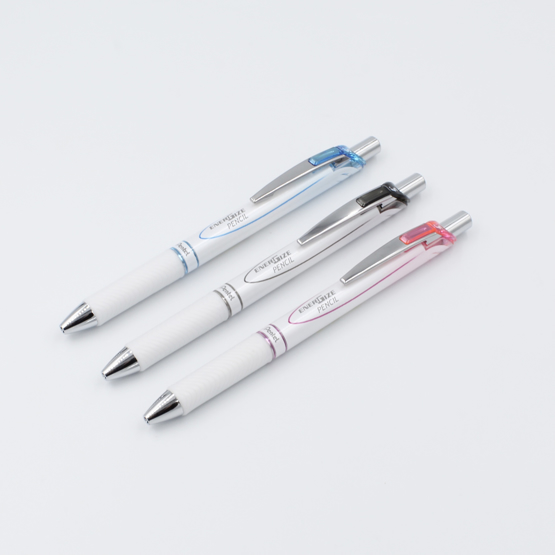Mechanical Pencil Lead Size Comparison
Mechanical pencils are an essential tool for many stationery lovers, artists, writers, and students. They are convenient, refillable, and produce consistent lines. However, the pencil's lead size plays a significant role in determining the writing experience and final result.
Choosing the right mechanical pencil lead size can be a daunting task. With so many options available, it's easy to feel overwhelmed and not know where to start. But don't worry, Washi is here to help!
Common Mechanical Pencil Lead Sizes:
The most common mechanical pencil lead sizes are 0.5 mm, 0.7 mm, and 0.9 mm:
- The 0.5 mm lead size is the most popular and widely used. It produces a fine line, making it ideal for everyday writing and precise drawings. It's also a good choice for people who tend to write with a lighter hand. However, the lead can break more easily, so it may not be the best option for heavy-handed writers.
- The 0.7 mm lead size provides a little bolder line than the 0.5 mm due to its minor thickness increase. It strikes a decent balance between the 0.5 mm's thinness and the 0.9 mm's thickness. Additionally, it's an excellent choice for everyday writing and drawing.
- Of the three typical sizes, the 0.9 mm lead size provides the boldest line. It's perfect for those who write or draw with a heavy hand or who like broader lines. It's an excellent choice for filling in and shading huge areas as well.
It's crucial to take the user's writing or drawing style into account when comparing the three typical mechanical pencil lead sizes. The best lead size for general use is 0.5 mm, whereas the best lead size for heavier-duty applications is 0.9 mm. A decent all-around choice that may be used for a range of tasks is a lead size of 0.7 mm.

Uncommon Mechanical Pencil Lead Sizes
Aside from the common mechanical pencil lead sizes, there are also less common sizes available. These sizes range from 0.3 mm to 2.0 mm, and each has its own unique characteristics:
- The 0.3 mm lead size produces an ultra-fine line, making it an excellent choice for detailed work and precise drawings. It's also less prone to breakage than the 0.5 mm lead size. However, it may not be suitable for heavy-handed writers.
- The 0.4 mm lead size is slightly thicker than the 0.3 mm and produces a slightly bolder line. It's a good option for those who prefer a finer line than the 0.5 mm but want more durability than the 0.3 mm.
- For people who prefer thicker lines in their writing or sketching, the 0.6 mm lead size is an excellent option because it provides a thicker line than the 0.5 mm. It's an excellent choice for filling in and shading huge areas as well.
- The 1.3 mm lead size creates an even bolder line than the usual lead sizes since it is thicker. It's a wonderful alternative for those who have a heavy hand or prefer to draw or write with thick lines.
- The 2.0 mm lead size generates an extremely bold line and is the thickest mechanical pencil lead size available. It's a great alternative for filling up big spaces or for massive drawings and doodles.
Choosing the Right Mechanical Pencil Lead Size
When choosing a mechanical pencil lead size, it's important to consider your individual needs and preferences. Here are some tips to help you choose the right lead size:
Consider the intended use: The first step in choosing the right lead size is to consider the intended use. If you are primarily using the pencil for writing or general note-taking, a 0.5 mm or 0.7 mm lead size may be the best option. If you are drawing or sketching, you may want to consider a 0.9 mm or larger lead size.
Consider your writing or drawing style: Your writing or drawing style can also impact the lead size you choose. If you tend to have a heavy hand, a thicker lead size may be more suitable. If you have a lighter touch, a thinner lead size may be a better choice.
Experiment with different sizes: Sometimes, the best way to determine the right lead size is to try out different sizes and see which one feels most comfortable and produces the desired results.
The lead's quality: should be taken into consideration because it can affect the writing or drawing process. Leads of higher grade are typically smoother and more robust, whereas leads of poorer quality may smear or break more easily.
Take into account the price: Deciding on the appropriate size may also depend on the lead's price. When choosing between lead sizes, it's crucial to keep in mind that some may be more expensive than others.
Conclusion
To have the optimal writing or drawing experience, picking the proper mechanical pencil lead size is crucial. Each lead size has distinct qualities that can affect the outcome, from the popular 0.5 mm lead size to the less popular 2.0 mm lead size. Finding the ideal lead size for your purposes involves taking into account the intended application, writing or drawing style, lead quality, and cost.